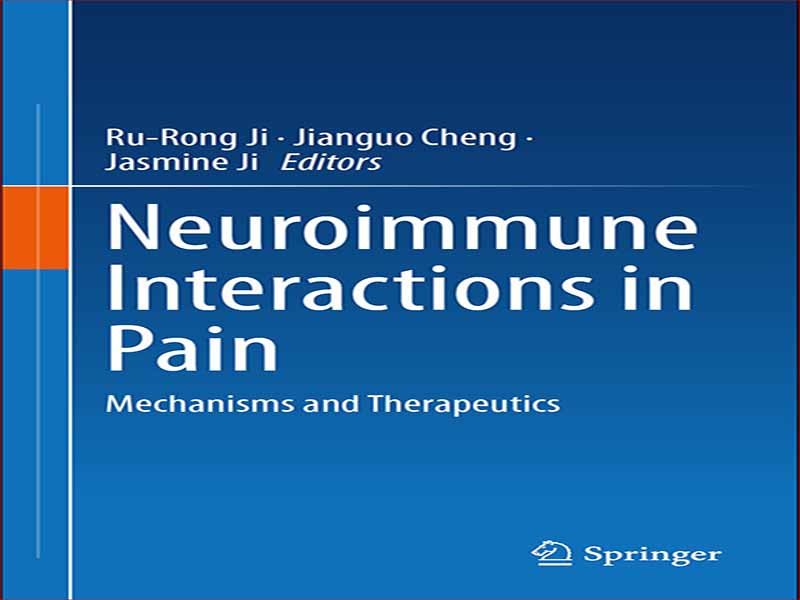- عنوان کتاب: Neuroimmune Interactions in Pain
- نویسنده: Ru-Rong Ji
- سال انتشار: 2023
- حوزه: علوم اعصاب, درد
- تعداد صفحه: 365
- زبان اصلی: انگلیسی
- نوع فایل: pdf
- حجم فایل: 12.0 مگابایت
درد بار عظیمی را بر سیستم مراقبت های بهداشتی و همچنین کیفیت زندگی افراد در سراسر جهان تحمیل می کند و تنها در ایالات متحده بیش از 600 میلیارد دلار هزینه اقتصادی دارد. با وجود این بار مالی عظیم بر جامعه، درمانهای فعلی ناکافی هستند و اغلب عوارض جانبی شدیدی ایجاد میکنند. التهاب پاسخ طبیعی بدن به آسیب یا خمش است و با پنج علامت اصلی تعریف می شود: قرمزی، گرما، تورم، از دست دادن عملکرد و درد. به عنوان یکی از ویژگی های اصلی درد، التهاب از طریق واسطه های پیش التهابی باعث ایجاد درد می شود. در همین حال، شواهد اخیر نشان میدهد که التهاب با تولید واسطههای پیشحلکننده، مانند واسطههای تخصصی حلکننده (SPMs)، مشتقشده از مولکولهایی از جمله اسیدهای چرب غیراشباع امگا 3، منجر به رفع درد نیز میشود. هنگامی که التهاب حاد به موقع قابل حل نباشد، التهاب مزمن در بسیاری از بیماری های شناخته شده ایجاد می شود که منجر به درد مزمن می شود. در حالی که درد حاد عملکردهای هشدار دهنده مفیدی دارد، درد مزمن چنین هدف محافظتی ندارد و کیفیت زندگی بیماران را به شدت کاهش می دهد. مشخصه خاص کووید-19 پاسخ های التهابی قوی و گسترده ناشی از عفونت ویروسی است که می تواند منجر به ایجاد طیف گسترده ای از شرایط درد جدید و همچنین تشدید و طولانی شدن دردهای موجود شود. تعداد زیادی از متون انباشته شده در سه دهه اخیر نشان داده اند که سیستم ایمنی از طریق تعامل با نورون های حسی، درد را تعدیل می کند، زیرا واسطه های التهابی می توانند فعالیت یا حساسیت نورون های حس کننده درد (گیرنده های درد) را در شرایط مختلف فیزیولوژیکی و پاتولوژیک تنظیم کنند یا کاهش دهند. . به طور متناقض، برخی از درمان های ضد التهابی، مانند استروئیدها، می توانند درد حاد را مهار کنند، اما وضوح درد را مختل می کنند و منجر به درد مزمن می شوند.
Pain places an enormous burden on the healthcare system as well as the quality of life of individuals all around the world, with an economic cost over $600 billion in the United States alone. Despite this enormous financial burden on society, current treatments are inadequate and often produce severe side effects. Inflammation is the body’s natural response to injury or inflection and is defined by five cardinal signs: redness, heat, swelling, loss of function, and pain. As a cardinal feature of pain, inflammation elicits pain through pro-inflammatory mediators. Meanwhile, recent evidence suggests that inflammation also leads to pain resolution by generating pro-resolving mediators, such as specialized pro-resolving mediators (SPMs), derived from molecules including omega-3 unsaturated fatty acids. When acute inflammation cannot be timely resolved, chronic inflammation will develop in many known disease conditions leading to chronic pain. While acute pain serves beneficial warning functions, chronic pain has no such protective purpose and severely degrades the quality of life of patients. A particular hallmark of the COVID-19 is the viral infection-triggered robust and widespread inflammatory responses, which could lead to the development of a wide range of new pain conditions as well as the exacerbation and prolongation of existing pains. A large body of literatures accumulated in the last three decades has demonstrated that immune system modulates pain via interactions with sensory neurons, as inflammatory mediators can either upregulate or downregulate the activity or sensitivity of pain-sensing neurons (nociceptors) in different physiological and pathological conditions. Paradoxically, some anti-inflammatory treatments, such as steroids, can inhibit acute pain but impair the resolution of pain, leading to chronic pain.
این کتاب را میتوانید از لینک زیر بصورت رایگان دانلود کنید:
Download: Neuroimmune Interactions in Pain



































نظرات کاربران